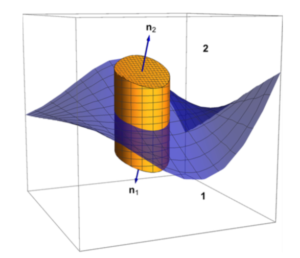[Click here for a PDF version of this post]
Motivation.
Suppose that we want to represent GA(2,0) (Euclidean) multivectors as a pair of complex numbers, with a structure like
\begin{equation}\label{eqn:bicomplexGA20:20}
M = (m_1, m_2),
\end{equation}
where
\begin{equation}\label{eqn:bicomplexGA20:40}
\begin{aligned}
\gpgrade{M}{0,2} &\sim m_1 \\
\gpgrade{M}{1} &\sim m_2.
\end{aligned}
\end{equation}
Specifically
\begin{equation}\label{eqn:bicomplexGA20:60}
\begin{aligned}
\gpgrade{M}{0} &= \textrm{Re}(m_1) \\
\gpgrade{M}{1} \cdot \Be_1 &= \textrm{Re}(m_2) \\
\gpgrade{M}{1} \cdot \Be_2 &= \textrm{Im}(m_2) \\
\gpgrade{M}{2} i^{-1} &= \textrm{Im}(m_1),
\end{aligned}
\end{equation}
where \( i \sim \Be_1 \Be_2 \).
Multivector product representation.
Let’s figure out how we can represent the various GA products, starting with the geometric product. Let
\begin{equation}\label{eqn:bicomplexGA20:80}
\begin{aligned}
M &= \gpgrade{M}{0,2} + \gpgrade{M}{1} = (m_1, m_2) = (m_{11} + m_{12} i, m_{21} + m_{22} i) \\
N &= \gpgrade{N}{0,2} + \gpgrade{N}{1} = (n_1, n_2) = (n_{11} + n_{12} i, n_{21} + n_{22} i),
\end{aligned}
\end{equation}
so
\begin{equation}\label{eqn:bicomplexGA20:200}
\begin{aligned}
M N
&= \gpgrade{M}{0,2} \gpgrade{N}{0,2} + \gpgrade{M}{1} \gpgrade{N}{1} \\
&\quad+ \gpgrade{M}{1} \gpgrade{N}{0,2} + \gpgrade{M}{0,2} \gpgrade{N}{1}
\end{aligned}
\end{equation}
The first two terms have only even grades, and the second two terms are vectors. The complete representation of the even grade components of this multivector product is
\begin{equation}\label{eqn:bicomplexGA20:240}
\gpgrade{M N}{0,2} \sim \lr{ m_1 n_1 + \textrm{Re}(m_2 n_2^\conj) – i \textrm{Im}(m_2 n_2^\conj), 0 },
\end{equation}
or
\begin{equation}\label{eqn:bicomplexGA20:260}
\begin{aligned}
\gpgrade{M N}{0} &= \textrm{Re}\lr{ m_1 n_1 + m_2 n_2^\conj } \\
\gpgrade{M N}{2} i^{-1} &= \textrm{Im}\lr{ m_1 n_1 – m_2 n_2^\conj }.
\end{aligned}
\end{equation}
For the vector components we have
\begin{equation}\label{eqn:bicomplexGA20:280}
\begin{aligned}
\gpgrade{M N}{1}
&=
\gpgrade{M}{1} \gpgrade{N}{0} + \gpgrade{M}{0} \gpgrade{N}{1}
+
\gpgrade{M}{1} \gpgrade{N}{2} + \gpgrade{M}{2} \gpgrade{N}{1} \\
&= \gpgrade{M}{1} n_{11} + m_{11} \gpgrade{N}{1} + \gpgrade{M}{1} i n_{12} + i m_{12} \gpgrade{N}{1}.
\end{aligned}
\end{equation}
For these,
\begin{equation}\label{eqn:bicomplexGA20:300}
\begin{aligned}
\gpgrade{M}{1} i
&= \lr{ m_{21} \Be_1 + m_{22} \Be_2 } \Be_{12}
&= – m_{22} \Be_1 + m_{21} \Be_2,
\end{aligned}
\end{equation}
and
\begin{equation}\label{eqn:bicomplexGA20:320}
\begin{aligned}
i \gpgrade{N}{1}
&= \Be_{12} \lr{ n_{21} \Be_1 + n_{22} \Be_2 }
&=
n_{22} \Be_1 – n_{21} \Be_2.
\end{aligned}
\end{equation}
Comparing to
\begin{equation}\label{eqn:bicomplexGA20:340}
i (a + i b)
= -b + i a,
\end{equation}
we see that
\begin{equation}\label{eqn:bicomplexGA20:360}
\gpgrade{M N}{1}
\sim
\lr{ 0, n_{11} m_2 + m_{11} n_2 + n_{12} i m_2 – m_{12} i n_2 }.
\end{equation}
If we want the vector coordinates, those are
\begin{equation}\label{eqn:bicomplexGA20:380}
\begin{aligned}
\gpgrade{M N}{1} \cdot \Be_1 &= \textrm{Re} \lr{ n_{11} m_2 + m_{11} n_2 + n_{12} i m_2 – m_{12} i n_2 } \\
\gpgrade{M N}{1} \cdot \Be_2 &= \textrm{Im} \lr{ n_{11} m_2 + m_{11} n_2 + n_{12} i m_2 – m_{12} i n_2 }.
\end{aligned}
\end{equation}
Summary.
\begin{equation}\label{eqn:bicomplexGA20:n}
M N \sim
\lr{ m_1 n_1 + \textrm{Re}(m_2 n_2^\conj) – i \textrm{Im}(m_2 n_2^\conj), n_{11} m_2 + m_{11} n_2 + n_{12} i m_2 – m_{12} i n_2 }.
\end{equation}
A sample Mathematica implementation is available, as well as an example notebook (that also doubles as a test case.)
Clarification.
I skipped a step above, showing the correspondances to the dot and wedge product.
Let \(z = a + bi\), and \(w = c + di\). Then:
\begin{equation}\label{eqn:bicomplexGA20:420}
\begin{aligned}
z w^\conj
&=
\lr{ a + b i } \lr{ c – d i } \\
&= a c + b d -i \lr{ a d – b c }.
\end{aligned}
\end{equation}
Compare that to the geometric product of two vectors \( \Bx = a \Be_1 + b \Be_2 \), and \( \By = c \Be_1 + d \Be_2 \), where we have
\begin{equation}\label{eqn:bicomplexGA20:440}
\begin{aligned}
\Bx \By &= \Bx \cdot \By + \Bx \wedge \By \\
&= \lr{ a \Be_1 + b \Be_2 } \lr{ c \Be_1 + d \Be_2 } \\
&= a c + b d + \Be_1 \Be_2 \lr{ a d – b c }.
\end{aligned}
\end{equation}
So we have
\begin{equation}\label{eqn:bicomplexGA20:460}
\begin{aligned}
a b + cd &= \Bx \cdot \By = \textrm{Re} \lr{ z w^\conj } \\
a d – b c &= \lr{ \Bx \wedge \By } \Be_{12}^{-1} = – \textrm{Im} \lr{ z w^\conj }.
\end{aligned}
\end{equation}
We see that \( \lr{z w^\conj}^\conj = z^\conj w \) can be used as a representation of the geometric product of two vectors (setting \( i = \Be_1 \Be_2 \) as usual.)
Another simplification.
We have sums of the form
\begin{equation}\label{eqn:bicomplexGA20:480}
\textrm{Re}(z) w \pm \textrm{Im}(z) i w
\end{equation}
above. Let’s see if those can be simplified. For the positive case we have
\begin{equation}\label{eqn:bicomplexGA20:500}
\begin{aligned}
\textrm{Re}(z) w + \textrm{Im}(z) i w
&=
\inv{2} \lr{ z + z^\conj } w + \inv{2} \lr{ z – z^\conj } w \\
&=
z w,
\end{aligned}
\end{equation}
and for the negative case, we have
\begin{equation}\label{eqn:bicomplexGA20:520}
\begin{aligned}
\textrm{Re}(z) w – \textrm{Im}(z) i w
&=
\inv{2} \lr{ z + z^\conj } w – \inv{2} \lr{ z – z^\conj } w \\
&=
z^\conj w.
\end{aligned}
\end{equation}
This, with the vector-vector product simplification above, means that we can represent the full multivector product in this representation as just
\begin{equation}\label{eqn:bicomplexGA20:540}
M N \sim
\lr{ m_1 n_1 + m_2^\conj n_2, m_2 n_1 + m_1^\conj n_2 }.
\end{equation}





